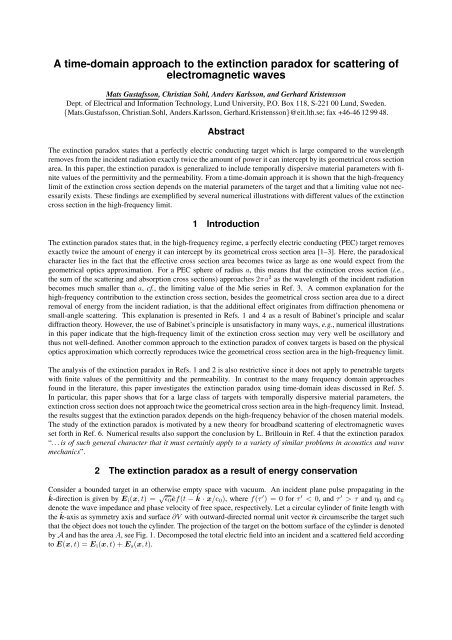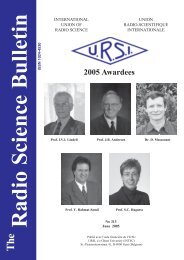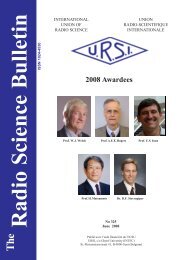A time-domain approach to the extinction paradox for ... - URSI
A time-domain approach to the extinction paradox for ... - URSI
A time-domain approach to the extinction paradox for ... - URSI
You also want an ePaper? Increase the reach of your titles
YUMPU automatically turns print PDFs into web optimized ePapers that Google loves.
A <strong>time</strong>-<strong>domain</strong> <strong>approach</strong> <strong>to</strong> <strong>the</strong> <strong>extinction</strong> <strong>paradox</strong> <strong>for</strong> scattering of<br />
electromagnetic waves<br />
Mats Gustafsson, Christian Sohl, Anders Karlsson, and Gerhard Kristensson<br />
Dept. of Electrical and In<strong>for</strong>mation Technology, Lund University, P.O. Box 118, S-221 00 Lund, Sweden.<br />
{Mats.Gustafsson, Christian.Sohl, Anders.Karlsson, Gerhard.Kristensson}@eit.lth.se; fax +46-46 12 99 48.<br />
Abstract<br />
The <strong>extinction</strong> <strong>paradox</strong> states that a perfectly electric conducting target which is large compared <strong>to</strong> <strong>the</strong> wavelength<br />
removes from <strong>the</strong> incident radiation exactly twice <strong>the</strong> amount of power it can intercept by its geometrical cross section<br />
area. In this paper, <strong>the</strong> <strong>extinction</strong> <strong>paradox</strong> is generalized <strong>to</strong> include temporally dispersive material parameters with finite<br />
values of <strong>the</strong> permittivity and <strong>the</strong> permeability. From a <strong>time</strong>-<strong>domain</strong> <strong>approach</strong> it is shown that <strong>the</strong> high-frequency<br />
limit of <strong>the</strong> <strong>extinction</strong> cross section depends on <strong>the</strong> material parameters of <strong>the</strong> target and that a limiting value not necessarily<br />
exists. These findings are exemplified by several numerical illustrations with different values of <strong>the</strong> <strong>extinction</strong><br />
cross section in <strong>the</strong> high-frequency limit.<br />
1 Introduction<br />
The <strong>extinction</strong> <strong>paradox</strong> states that, in <strong>the</strong> high-frequency regime, a perfectly electric conducting (PEC) target removes<br />
exactly twice <strong>the</strong> amount of energy it can intercept by its geometrical cross section area [1–3]. Here, <strong>the</strong> <strong>paradox</strong>ical<br />
character lies in <strong>the</strong> fact that <strong>the</strong> effective cross section area becomes twice as large as one would expect from <strong>the</strong><br />
geometrical optics approximation. For a PEC sphere of radius a, this means that <strong>the</strong> <strong>extinction</strong> cross section (i.e.,<br />
<strong>the</strong> sum of <strong>the</strong> scattering and absorption cross sections) <strong>approach</strong>es 2πa 2 as <strong>the</strong> wavelength of <strong>the</strong> incident radiation<br />
becomes much smaller than a, cf., <strong>the</strong> limiting value of <strong>the</strong> Mie series in Ref. 3. A common explanation <strong>for</strong> <strong>the</strong><br />
high-frequency contribution <strong>to</strong> <strong>the</strong> <strong>extinction</strong> cross section, besides <strong>the</strong> geometrical cross section area due <strong>to</strong> a direct<br />
removal of energy from <strong>the</strong> incident radiation, is that <strong>the</strong> additional effect originates from diffraction phenomena or<br />
small-angle scattering. This explanation is presented in Refs. 1 and 4 as a result of Babinet’s principle and scalar<br />
diffraction <strong>the</strong>ory. However, <strong>the</strong> use of Babinet’s principle is unsatisfac<strong>to</strong>ry in many ways, e.g., numerical illustrations<br />
in this paper indicate that <strong>the</strong> high-frequency limit of <strong>the</strong> <strong>extinction</strong> cross section may very well be oscilla<strong>to</strong>ry and<br />
thus not well-defined. Ano<strong>the</strong>r common <strong>approach</strong> <strong>to</strong> <strong>the</strong> <strong>extinction</strong> <strong>paradox</strong> of convex targets is based on <strong>the</strong> physical<br />
optics approximation which correctly reproduces twice <strong>the</strong> geometrical cross section area in <strong>the</strong> high-frequency limit.<br />
The analysis of <strong>the</strong> <strong>extinction</strong> <strong>paradox</strong> in Refs. 1 and 2 is also restrictive since it does not apply <strong>to</strong> penetrable targets<br />
with finite values of <strong>the</strong> permittivity and <strong>the</strong> permeability. In contrast <strong>to</strong> <strong>the</strong> many frequency <strong>domain</strong> <strong>approach</strong>es<br />
found in <strong>the</strong> literature, this paper investigates <strong>the</strong> <strong>extinction</strong> <strong>paradox</strong> using <strong>time</strong>-<strong>domain</strong> ideas discussed in Ref. 5.<br />
In particular, this paper shows that <strong>for</strong> a large class of targets with temporally dispersive material parameters, <strong>the</strong><br />
<strong>extinction</strong> cross section does not <strong>approach</strong> twice <strong>the</strong> geometrical cross section area in <strong>the</strong> high-frequency limit. Instead,<br />
<strong>the</strong> results suggest that <strong>the</strong> <strong>extinction</strong> <strong>paradox</strong> depends on <strong>the</strong> high-frequency behavior of <strong>the</strong> chosen material models.<br />
The study of <strong>the</strong> <strong>extinction</strong> <strong>paradox</strong> is motivated by a new <strong>the</strong>ory <strong>for</strong> broadband scattering of electromagnetic waves<br />
set <strong>for</strong>th in Ref. 6. Numerical results also support <strong>the</strong> conclusion by L. Brillouin in Ref. 4 that <strong>the</strong> <strong>extinction</strong> <strong>paradox</strong><br />
“...is of such general character that it must certainly apply <strong>to</strong> a variety of similar problems in acoustics and wave<br />
mechanics”.<br />
2 The <strong>extinction</strong> <strong>paradox</strong> as a result of energy conservation<br />
Consider a bounded target in an o<strong>the</strong>rwise empty space with vacuum. An incident plane pulse propagating in <strong>the</strong><br />
ˆk-direction is given by E i (x,t)= √ ɛ 0 êf(t − ˆk · x/c 0 ), where f(τ ′ )=0<strong>for</strong> τ ′ < 0, and τ ′ >τand η 0 and c 0<br />
denote <strong>the</strong> wave impedance and phase velocity of free space, respectively. Let a circular cylinder of finite length with<br />
<strong>the</strong> ˆk-axis as symmetry axis and surface ∂V with outward-directed normal unit vec<strong>to</strong>r ˆn circumscribe <strong>the</strong> target such<br />
that <strong>the</strong> object does not <strong>to</strong>uch <strong>the</strong> cylinder. The projection of <strong>the</strong> target on <strong>the</strong> bot<strong>to</strong>m surface of <strong>the</strong> cylinder is denoted<br />
by A and has <strong>the</strong> area A, see Fig. 1. Decomposed <strong>the</strong> <strong>to</strong>tal electric field in<strong>to</strong> an incident and a scattered field according<br />
<strong>to</strong> E(x,t)=E i (x,t)+E s (x,t).
a)<br />
A<br />
@V<br />
n^<br />
V<br />
b)<br />
E i<br />
k^<br />
t=t 0<br />
Object<br />
E s PEC<br />
1<br />
c<br />
c =1<br />
10<br />
c 1=1<br />
&=0<br />
E<br />
i i<br />
s ^<br />
E=E +E =0<br />
k<br />
0<br />
1<br />
2 3 4<br />
t=t 1<br />
Figure 1: a) The temporal and spatial support of <strong>the</strong> scattered and incident fields <strong>for</strong> an object with a phase velocity<br />
c ∞ < c 0 . b) Illustrations of <strong>the</strong> shadow regions <strong>for</strong> various scattering targets.<br />
The extincted energy is <strong>the</strong> sum of <strong>the</strong> absorbed and scattered energies at a sufficiently large <strong>time</strong> (t = ∞)<br />
∫ ∫<br />
(<br />
− E(x,t) × H(x,t) − Es (x,t) × H s (x,t) ) · ˆn(x)dSdt<br />
R ∂V<br />
∫ ∫<br />
(<br />
= − Ei (x,t) × H s (x,t)+E s (x,t) × H i (x,t) ) · ˆn(x)dSdt (1)<br />
R ∂V<br />
Causality ensures that when <strong>the</strong> pulse width goes <strong>to</strong> zero, τ → 0, <strong>the</strong> support of <strong>the</strong> incident and scattered fields can<br />
only overlap at <strong>the</strong> planar surface A with outward-directed unit normal vec<strong>to</strong>r ˆn = ˆk. This simplifies (1) <strong>to</strong><br />
∫<br />
W ext = −c 0 lim μ 0 H i (x,t) · H s (x,t)+ɛ 0 E s (x,t) · E i (x,t)dSdt. (2)<br />
τ→0<br />
∫R A<br />
Define <strong>the</strong> short pulse <strong>extinction</strong> cross section as <strong>the</strong> quotient between <strong>the</strong> extincted energy and <strong>the</strong> incident energy<br />
flux, i.e.,<br />
Σ ext =<br />
W ext<br />
∫<br />
c 0 R |f(τ =2A − lim<br />
′ )| 2 dτ<br />
′ τ→0<br />
∫<br />
R<br />
∫<br />
A ɛ 0E(x,t) · E i (x,t)+μ 0 H i (x,t) · H(x,t)dSdt<br />
∫R |f(τ ′ )| 2 dτ ′ . (3)<br />
The short pulse <strong>extinction</strong> cross section depends on <strong>the</strong> geometry of <strong>the</strong> target and its material parameters. Here, an<br />
isotropic non-magnetic material is considered with a <strong>the</strong> <strong>time</strong>-<strong>domain</strong> constitutive relation given by D = ɛ 0 (ɛ ∞ E +<br />
χ∗E), where χ(t) denotes <strong>the</strong> susceptibility kernel and ∗ denotes temporal convolution. The corresponding frequency<br />
<strong>domain</strong> relations are quantified by <strong>the</strong> permittivity ɛ(ω), where ω denotes <strong>the</strong> angular frequency. The following four<br />
important special cases as illustrated in Fig 1:<br />
1. The target is perfectly electric conducting (PEC). In this case E · E i =0and H · H i =0when x ∈Aand<br />
hence Σ ext =2A.<br />
2. The target is a dielectric material with an optical response ɛ ∞ > 1. The wave front travels with <strong>the</strong> phase<br />
velocity c ∞ =c 0 / √ ɛ ∞ in <strong>the</strong> target implying that E ·E i =0and H ·H i =0when x ∈A. Hence Σ ext =2A.<br />
3. The object is a dispersive medium with phase velocity c ∞ =c 0 and χ(0) > 0, or equivalently ɛ(ω) =1−<br />
iς/ω + O(ω −2 ) as ω →∞, where ς =1/χ(0), cf., <strong>the</strong> Debye and conductivity models. The wave front<br />
travels with <strong>the</strong> speed c 0 but is attenuated. One can show that <strong>the</strong> shape of <strong>the</strong> wave front is unaffected by <strong>the</strong><br />
object but that attenuated by a fac<strong>to</strong>r of exp(−χ(0)Δl/2c 0 ) when it travels a distance Δl in <strong>the</strong> medium. Thus<br />
0 < E i · E < |E i | 2 when x ∈Aand hence 0 < Σ ext < 2A.<br />
4. The object is a dispersive medium with phase velocity c ∞ =c 0 and χ(0) = 0, or equivalently ɛ(ω) =1+<br />
O(ω −2 ) as ω →∞, cf., <strong>the</strong> Lorentz model. In this case <strong>the</strong> wave front is not affected by <strong>the</strong> medium and hence<br />
Σ ext =0.
4<br />
¾<br />
ext/A<br />
z^<br />
k^<br />
3.5<br />
3<br />
2.5<br />
2<br />
1.5<br />
1<br />
0.45a<br />
0.5<br />
50 100 150 200 250<br />
ka<br />
0.45a<br />
0.55a<br />
0.55a<br />
Figure 2: The <strong>extinction</strong> cross section and running averages <strong>extinction</strong> cross section in units of <strong>the</strong> geometrical cross<br />
section area A = πa 2 <strong>for</strong> <strong>the</strong> PEC geometry depicted on <strong>the</strong> right hand side.<br />
The first two cases are <strong>the</strong> <strong>time</strong> <strong>domain</strong> (or short pulse) analogy of <strong>the</strong> <strong>extinction</strong> <strong>paradox</strong>, i.e., <strong>the</strong> energy an object<br />
absorbs and scatters is twice <strong>the</strong> amount that it intercepts by its geometrical cross section area. It is illustrative <strong>to</strong> relate<br />
<strong>the</strong> <strong>time</strong>-<strong>domain</strong> <strong>extinction</strong> <strong>paradox</strong> <strong>to</strong> <strong>the</strong> corresponding high-frequency version. Fourier syn<strong>the</strong>sis of <strong>the</strong> short pulse<br />
<strong>extinction</strong> cross section is<br />
∫ ∞<br />
0<br />
Σ ext (ˆk, ê) = lim<br />
τ→0<br />
σ ext (ω; ˆk, ê)|g(ω)| 2 dω<br />
∫ ∞ , (4)<br />
|g(ω)|<br />
0<br />
2 dω<br />
where σ ext denotes <strong>the</strong> <strong>extinction</strong> cross section and g(ω) is <strong>the</strong> Fourier trans<strong>for</strong>m of f(t). Although, <strong>the</strong> derivation is<br />
based on a finite pulse width, it can be generalized, giving<br />
∫ ω<br />
1<br />
Σ ext (ˆk, ê) = lim σ ext (ω ′ ;<br />
ω→∞ ω<br />
ˆk, ê) dω ′ , (5)<br />
0<br />
where it is seen that <strong>the</strong> running average of <strong>the</strong> <strong>extinction</strong> cross section <strong>approach</strong>es Σ ext in <strong>the</strong> high frequency limit.<br />
The <strong>extinction</strong> <strong>paradox</strong> <strong>the</strong>n reads: in <strong>the</strong> high frequency limit, on average <strong>the</strong> absorbed and scattered power of an<br />
object is less <strong>the</strong>n or equal <strong>to</strong> twice <strong>the</strong> power that it can intercept by its geometrical cross section area, where equality<br />
holds <strong>for</strong> objects with phase velocity c ∞ < c 0 .<br />
3 Numerical examples<br />
Numerical results <strong>for</strong> a truncated cone with a displaced <strong>to</strong>p, dielectric sphere, and temporal dispersive layered sphere<br />
are used <strong>to</strong> illustrate <strong>the</strong> high-frequency limit of <strong>the</strong> <strong>extinction</strong> cross section, running average <strong>extinction</strong> cross section,<br />
and <strong>the</strong> short pulse <strong>extinction</strong> cross section.<br />
The truncated cone with a displaced <strong>to</strong>p is illuminated by a plane wave incident along <strong>the</strong> symmetry axis, as depicted<br />
in Fig. 2. The object is PEC and has a geometrical cross section area A = πa 2 <strong>for</strong> ˆk = −ẑ. The <strong>extinction</strong> cross<br />
section is determined with a MoM code <strong>for</strong> 1 ≤ ka ≤ 250. A simple geometrical optics analysis suggests that it is<br />
only <strong>the</strong> rays that are reflected between <strong>the</strong> conical surfaces that can contribute <strong>to</strong> <strong>the</strong> <strong>for</strong>ward scattering. These rays<br />
are phase shifted causing a constructive and destructive interference pattern in <strong>the</strong> <strong>for</strong>ward scattering, and, hence, an<br />
oscilla<strong>to</strong>ry <strong>extinction</strong> cross section. Note that <strong>the</strong> oscillation frequency ka ≈ 14 ≈ 2π/0.45 is consistent with <strong>the</strong><br />
geometrical optics approximation. It is observed that high frequency limit of <strong>the</strong> <strong>extinction</strong> cross section does not<br />
exist. Moreover, σ ext does not simple oscillate symmetrically around 2A. However, <strong>the</strong> running average (5) of <strong>the</strong><br />
<strong>extinction</strong> cross section <strong>approach</strong>es 2A.
¾ ext=A<br />
4.5<br />
4<br />
3.5<br />
3<br />
2.5<br />
2<br />
1.5<br />
1<br />
0.5<br />
ka<br />
0<br />
0 50 100 150 200 250 300<br />
3.5<br />
3<br />
2.5<br />
2<br />
1.5<br />
1<br />
0.5<br />
¾ ext=A<br />
0<br />
0 50 100 150 200 250 300<br />
ka<br />
Figure 3: The <strong>extinction</strong> cross section in units of <strong>the</strong> geometrical cross section area A = πa 2 <strong>for</strong> a sphere of radius<br />
a. The left figure represents a homogeneous sphere with a constant permittivity ɛ =2while <strong>the</strong> right figure is <strong>for</strong> a<br />
stratified sphere with a Lorentz dispersive media in <strong>the</strong> outermost layer. The corresponding running average <strong>extinction</strong><br />
cross sections are illustrated by <strong>the</strong> smoothly varying curves.<br />
The <strong>extinction</strong> cross section of a dielectric sphere with a constant permittivity ɛ =2is depicted <strong>to</strong> <strong>the</strong> left in Fig. 3. It is<br />
observed that σ ext oscillates around 2A and that <strong>the</strong> amplitude of <strong>the</strong> oscillations decreases with ka. The corresponding<br />
running averages <strong>extinction</strong> cross section (5) is given by <strong>the</strong> smooth curve that slowly <strong>approach</strong>es 2A. A stratified<br />
sphere with a PEC core (with radius a/2) surrounded by a Lorentz dispersive media is illustrating <strong>the</strong> effect of temporal<br />
dispersion on <strong>the</strong> short pulse <strong>extinction</strong> cross section. The Lorentz model is given by ɛ(κ) =1− κ 2 p/(κ 2 − κ 2 0 +iκν),<br />
where κ = ka, κ 0 = κ p =10, and ν =0.1κ 0 . It is observed that σ ext <strong>approach</strong>es A/2 as ka →∞in <strong>the</strong> right<br />
hand side of Fig. 3. This agrees with <strong>the</strong> general result as <strong>the</strong> wave front is unaffected by <strong>the</strong> Lorentz medium giving<br />
a shadow region defined by <strong>the</strong> projection of <strong>the</strong> PEC core. The convergence of <strong>the</strong> running average <strong>extinction</strong> cross<br />
section is seen <strong>to</strong> converge slower.<br />
4 Conclusions<br />
The <strong>time</strong> <strong>domain</strong> <strong>approach</strong> offers new insights in<strong>to</strong> <strong>the</strong> underlying physics of <strong>the</strong> <strong>extinction</strong> <strong>paradox</strong>. In contrast <strong>to</strong> <strong>the</strong><br />
classical frequency <strong>domain</strong> explanations, <strong>the</strong> new <strong>approach</strong> is solely based on energy conservation and causality and<br />
does not utilize ei<strong>the</strong>r scattering <strong>the</strong>ory nor high-frequency approximations. A short pulse <strong>extinction</strong> cross section is<br />
defined and shown <strong>to</strong> be bounded by twice <strong>the</strong> geometrical cross section area of <strong>the</strong> object. Moreover, it is shown that<br />
<strong>the</strong> running average of <strong>the</strong> high-frequency <strong>extinction</strong> cross section <strong>approach</strong>es <strong>the</strong> short pulse <strong>extinction</strong> cross section<br />
in <strong>the</strong> high frequency limit.<br />
References<br />
[1] H. van de Hulst. Light Scattering by Small Particles. New York: John Wiley & Sons, Inc., 1957.<br />
[2] C. F. Bohren and D. R. Huffman. Absorption and Scattering of Light by Small Particles. New York: John Wiley<br />
& Sons, 1983.<br />
[3] R. G. New<strong>to</strong>n. Scattering Theory of Waves and Particles. New York: Dover Publications, 2nd edn., 2002.<br />
[4] L. Brillouin. “The scattering cross section of spheres <strong>for</strong> electromagnetic waves”. Appl. Phys., vol. 20, pp. 1110–<br />
1125, 1949.<br />
[5] A. Karlsson. “On <strong>the</strong> <strong>time</strong> <strong>domain</strong> version of <strong>the</strong> optical <strong>the</strong>orem”. Am. J. Phys, vol. 68(4), pp. 344–349, 2000.<br />
[6] C. Sohl, M. Gustafsson, and G. Kristensson. “Physical limitations on broadband scattering by heterogeneous<br />
obstacles”. J. Phys. A: Math. Theor., vol. 40, pp. 11165–11182, 2007.
















